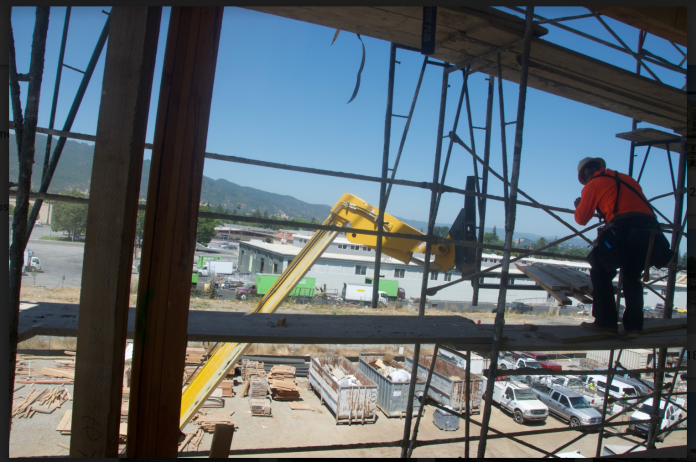Gilroy leaders worried last week about having a place for their children to live and work.
High housing costs and not enough jobs were threatening the lives they had planned, they said at a meeting of the Gilroy General Plan Advisory Committee. Millennials can’t afford to buy or rent a house, and there isn’t much nightlife to attract them here, officials said.
“Their generation of people leave Gilroy and don’t come back,” said City Council Member Cat Tucker. “There’s nothing here for them to do. There’s not the downtown like San Jose has. You speak to a lot of people around here who want a downtown like Los Gatos or Morgan Hill, these aren’t millennials. They want clubs like in San Jose. If they do come to Gilroy, they come back because they have got on their feet and they can afford a house. When they are young and single, no, there’s nothing in Gilroy to do, not only housing and cost issues. We went out on Friday night and there was nobody there. I asked, ‘Where is everybody?’”
Mayor Roland Velasco said the city needs to work toward keeping younger residents.
“Young people and singles like the energy and ambiance of living in the city,” he said. “We must work harder on the downtown and other amenities to keep them here.”
Those willing to endure the daily commute into San Jose are often seeking a small-town lifestyle and homes with yards. With a median home value in Gilroy of $689,200 compared to $1.2 million in Santa Clara County (including Gilroy), home buyers can get more bang for the buck in Gilroy.
Renters, who can pay less in Gilroy, will prefer to pay more in San Jose to avoid the commute and to be in a place where they can find the ambiance and convenience of city living. As the city grows and the specter of high-speed rail and the uncertainty that comes with it, many in Gilroy fear for the city’s small-town, agricultural ambiance. However, because of its growing population, which is projected to reach 61,400 by 2040 along with expansion limits that fit expansion limitations imposed by Measure H, the Garlic City will need to grow upwards, rather than outwards for residential units.
“In order to provide the rental housing supply that we discussed you have to use higher densities to make demand work,” Alex Sanchez, Executive Vice President of the Bay Area construction firm ROEM Corporation said.
With a lower median household income of $83,027 in Gilroy as compared to $96,310 in Santa Clara County, home buyers come to get more house and more yard for their dollar. However to keep up with the high cost of purchasing land, the rate of middle-class homes has struggled to Joseph Head, Managing Director for SummerHill Homes, paints a challenging housing situation in the San Jose area where costs are prohibitive. In order to afford a home that would be considered middle-class, a homebuyer would need to make 120 percent of the median income, which would be $99,632 annually in Gilroy. In Gilroy land sells at $200,000 per housing unit and $1,6 million per acre. Construction costs are $125 per square feet and $187,500 per unit. Including grading, streets, utilities, landscaping, storm drains and everything else that is included in building a home, another $80,000 per unit is added. A price tag per unit of housing costs $476,500 without city fees, insurance, loan cost, sales commissions or profit. Higher density building costs are more daunting, costing $250 per square foot and $375,000 per unit for construction alone.
“I don’t know what else the city can do, what we have done and what we’ve followed is what the general plan recommends,” Councilmember Cat Tucker said. “Right now we have four affordable projects that have been approved. It depends on the builders to build them. As of now, I feel we are on target with what we planned to do.”
As many young and educated Gilroyans embark on careers, staying in their hometown has become less and less desirable for many. With home prices beyond their purchase ability and the lack of amenities in town, like night clubs and a vibrant downtown, they will most often pay more to live near people their age.
Along with empty bars and restaurants, there are signs that the neighborly feel of Gilroy is going away.
“I have a new neighbor, next door, a young couple from San Jose and it’s been a year and I don’t know their names,” Tucker said. “I don’t know how many times I’ve waved to them and they never wave back. Until people have kids, they don’t want to be involved. That’s something new with Gilroy with people moving in. That’s what’s unique about Gilroy, we know our neighbors and people born and raised here like that kind of feel. Not everyone who moves here wants that. They want a cheaper house and a backyard. I’m on a committee at the Garlic Festival and I had a hard time getting volunteers. I never had a hard time getting volunteers and a lot of people felt that.”
Sanchez, cited Paso Robles as a possible source of inspiration as to how to grow the right way while keeping true to a city’s roots.
“They didn’t change their character or standards, they just remodeled their downtown effectively,” Sanchez said. “The planning department in Gilroy wants to be able to add the same positive impacts by maintaining the quality and cultural elements of the past but modernize at the same time.”
As existing property owners hope to sell their properties for top price, efforts made to revitalize downtown have often been stymied.
“We had a property downtown that we wished to buy so we could demolish the building and make park and plaza there,” Tucker said. “The owner wanted double the money. There are a lot of restrictions for government to buy property, you need to buy at fair market value. Just because the guy is gouging you and wanted way more than it was assessed at we couldn’t’ do it.”
With a short supply of available land the increase in demand has led to rising rents. As rents rise and incomes fail to increase at the same time, consumer spending lags behind.
“Rather than people spending money on shopping and restaurants, consumptive spending, they spend all their money on housing and transportation,” Sanchez said. “The traditional merchants are really losing out. They don’t have customers with money in their pockets. If you have higher density and more reasonable rent you can start attracting people who have the ability to consume products around town.”
Along with negative economic impacts, quality of life standards has taken a hit. The average commute time for workers in Santa Clara County has exploded. In 2010, commuters traveled 16,922,000 miles a day for their commute, which has jumped to 27,533,00 per day in 2014. In the coming years, this number is expected to rise. High-speed rail, while controversial in Gilroy, has a potential to ease the congestion and attract potential builders.
“It has to have downtown use,” said Sanchez. “That is going to encourage people to come into town or work in Gilroy. It does have a positive impact on traffic as well.”
Citing how the ROEM Corporation works with cities to develop around mass transportation, Sanchez spoke of a housing project currently under construction in Santa Rosa. Sonoma-Marin Area Rail Transit began service earlier in the month in Santa Rosa, prompting ROEM to buy 5.4 acres of property near Railroad Square for $5.75 million and is set to build an $85 million dollar mixed use residential and commercial project. For the ROEM Corporation, transportation was key to the deal.
“They had the track and trains and the money but they did not have federal permission to operate,” Sanchez said. “The city of Santa Rosa could not wait to get us in there but we chose not to do anything until the writing letters in Washington were released and the permit for the Sonoma-Marin Area Rail Transit to run the train.”
A plethora of complications regarding high-speed rail in Gilroy has yet to be resolved. Many feel that a downtown station would disrupt downtown businesses and that riders will not decide to stop and shop in Gilroy.
“You don’t want that to be a stop, you want it to be a destination,” Sanchez said of the high-speed rail in Gilroy. “You can’t make that a destination if you don’t have a commercial and residential mixture.”
Construction of large multi-resident housing complexes requires a lot of capital. According to Paul Ring, Vice President of Development for The Core Companies, each unit of housing requires between $500,000 and $1,000,000 to build and when making decisions where to build, they must factor in how much rent or sale value can be extracted per square foot of a given residence. Given the cost of construction, developers prefer to deal with cities that have a clear and coherent plan and that there is assurance that they will stick with plans when they are made.
“We have been to too many cities where it’s nice to read their specific plans for parts of town but then you see a giant stop sign when you get to the planning department,” Sanchez said. “We worked with one town where we had to go to the planning department 15 times because they wanted us to go away.”
At the time, ROEM Corporation does not have any plans currently in place in Gilroy. The company had previously had plans to build in Gilroy, but a deal fell through with the property holder. Still, Sanchez does find Gilroy to have elements desirable for a housing developer.
“It’s in the South Bay and there’s been tremendous development pressure in the Peninsula, San Jose, South San Jose and Morgan Hill and there’s some great stuff going on in Gilroy along Santa Teresa Boulevard,” Sanchez said. “I think all those things work well for Gilroy. There is a mature residential character and there are opportunities downtown and around downtown.”
There are also plenty of challenges in Gilroy. The cost of land in Gilroy, while lower than in San Jose, is still very high. The cost of land, taxes, permits, construction material and labor drives up costs. The single largest cost variable is land.
“In San Francisco, the cost of land per unit is three times as expensive than the actual structure,” Sanchez said. “Oakland is 1.5 times as expensive and San Jose is somewhere in between that. Gilroy’s land value has gone up and you can’t charge rent to cover those costs.”
With expected rents of comparable units for a two bedroom apartment in San Jose of $3,600 as compared to $2,900 in Gilroy, many developers feel they need utilize higher density to make projects financially viable.
“You just have to have enough density so that the seller of the land gets the same amount of money and the developer can build more units per acre than normally involved,” Sanchez said of balancing costs and affordable rent. “There’s a missing middle, where people are not able to get into subsidized housing but can’t afford market rate properties. So they’ll get stuck commuting from lower cost areas into San Jose but also into Gilroy.”
Still, city governments often shy away from encouraging home building, instead favoring commercial and industrial development that bring in higher tax revenue.
“Commercial and industrial pays the bills for police, fire, libraries and those kind of things,” Sanchez said. “When we build residential we bring in more people who want services. So we bring in people who want to consume these services.”
While the building of affordable housing the size of Alexander Station Apartments, the 262-unit project on the corner of 10th and Alexander street, is controversial in town, Sanchez believes it is in scale with what the city needs.
“I think that project is totally appropriate for that part of town,” Sanchez said. “It’s not an overwhelming or imposing kind of building and it’s in a commercial area. I see it as being compatible with the area.”














